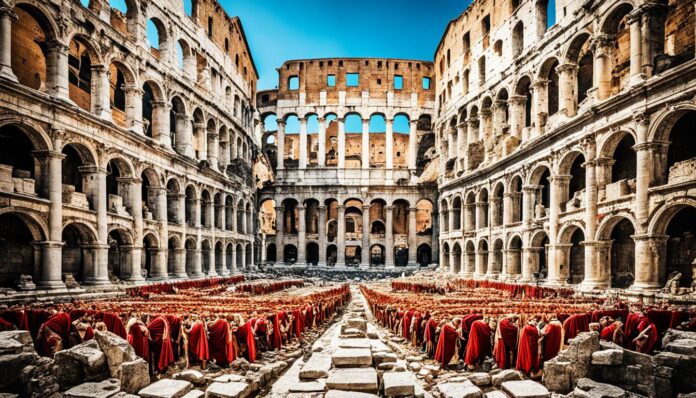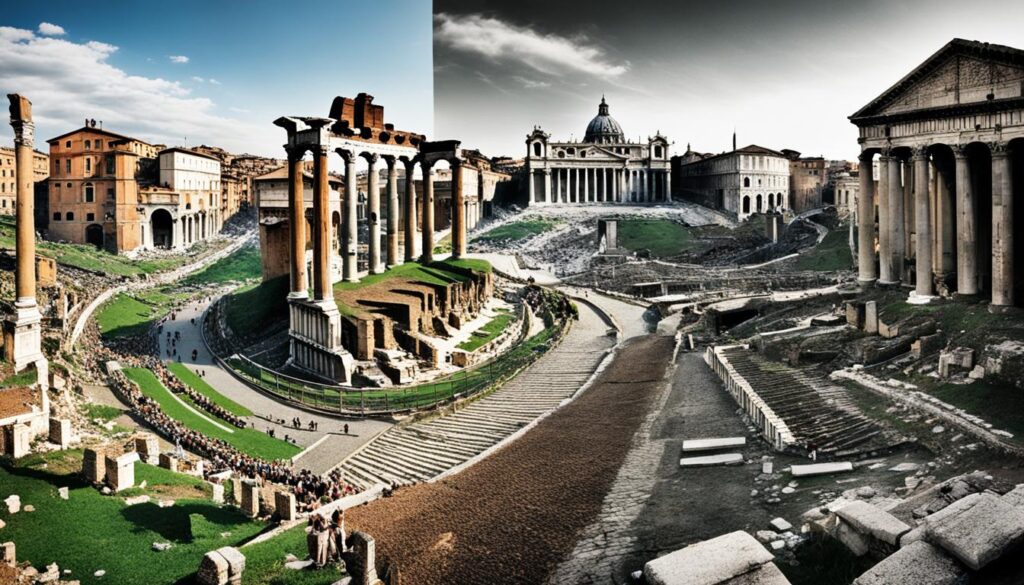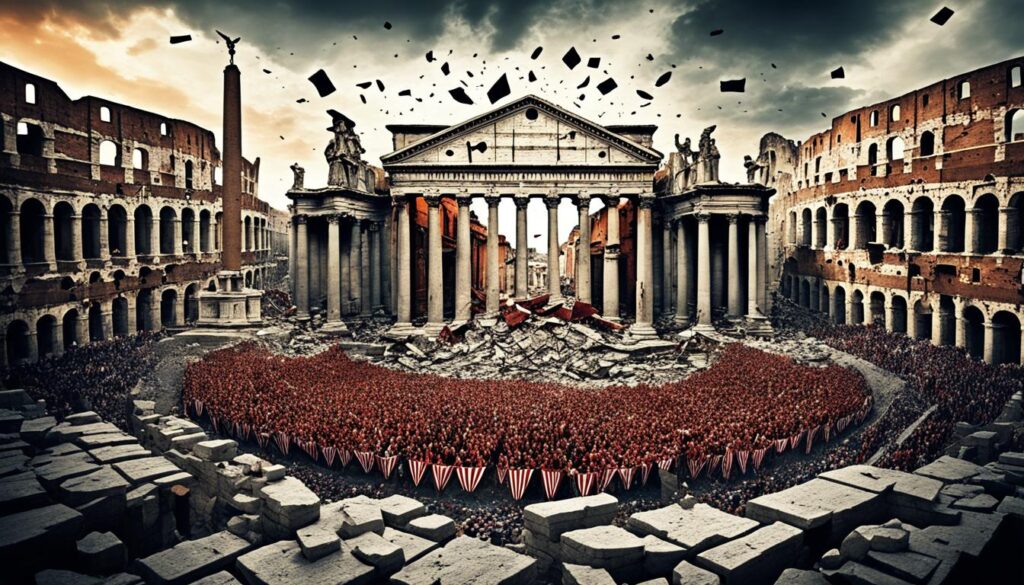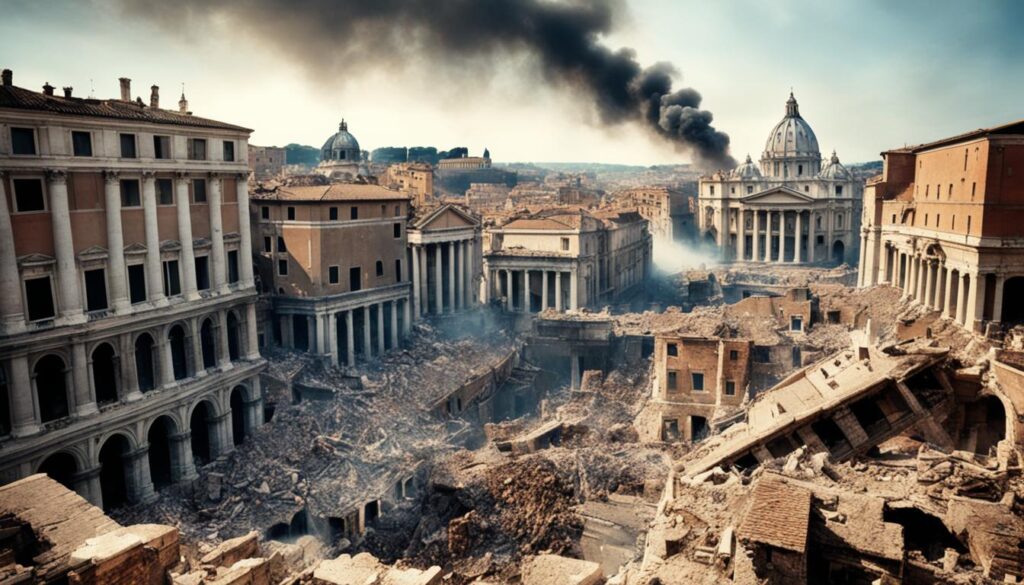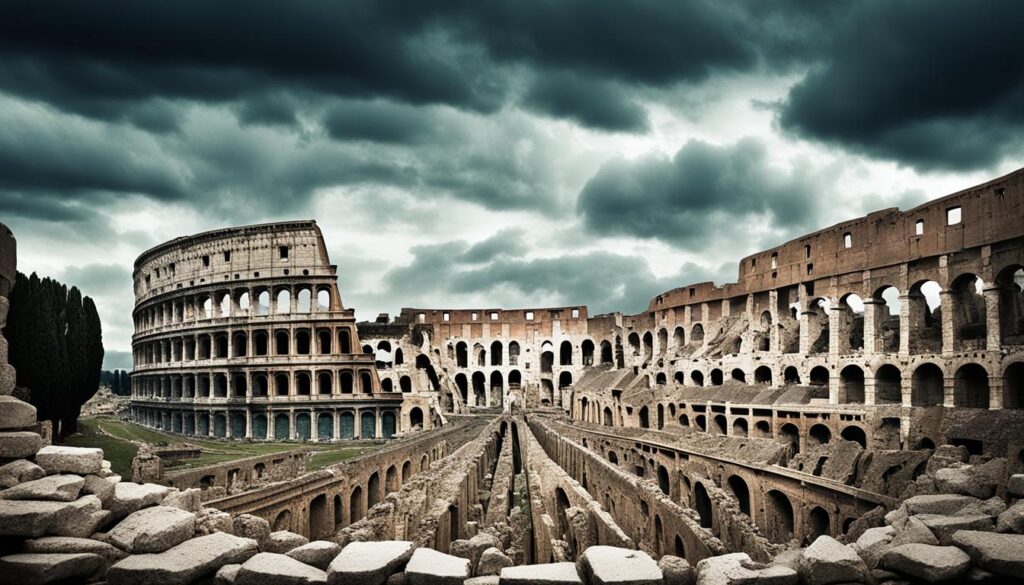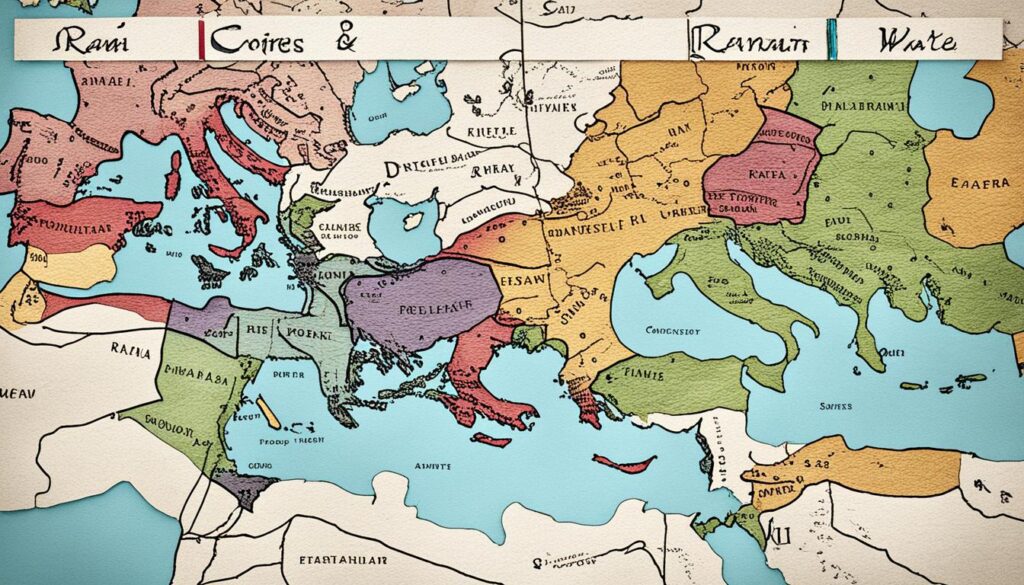Have you ever thought about why the great Roman Empire broke apart? What key events caused this big split? Let’s start our journey to find out the secrets behind the division of the Roman Empire.
We’ll explore the rise and fall of the Roman Empire. Including the Roman Republic’s collapse and the empire’s final split. We’ll look into crucial moments and major figures that changed history.
Why did Romans fight against each other in a fierce civil war? What effects did the empire’s split have on Byzantium’s rise and the Western Roman Empire’s fall? What legacy did this huge event leave in history?
Get set to solve these mysteries and question what you know. You’ll learn about power, leadership, and the ups and downs of empires. All the answers are waiting as we dive into the secrets of split Roman history.
The Rise of the Roman Empire
The story of Rome starts with a small city-state in Italy. It grew into a mighty civilization, changing the Western world. Through wars and alliances, Rome spread over centuries, building a vast empire.
The change from monarchy to republic happened in Rome between 509 BCE to 27 BCE. This shift led to a government by elected officials. Rome introduced a system to balance power, allowing citizens to have a say in governance.
Leaders like Julius Caesar and Augustus made Rome stable and strong. Caesar expanded the empire and was a great leader until his death in 44 BCE. His death caused a fight for power, ending the Roman Republic.
“I came, I saw, I conquered.” – Julius Caesar
After Caesar’s death, Augustus won the power struggle. He became the first emperor and started a peaceful and prosperous era called the Pax Romana.
Rome’s success wasn’t just from fighting. It was also good at making its conquered people feel like part of Rome. Offering citizenship helped keep the empire united and loyal.
- Rome grew by winning battles and taking over places like Greece, Egypt, and Gaul.
- It moved from being ruled by kings to a republic, where people had more power.
- Figures like Caesar and Augustus were crucial in making Rome a dominant empire.
- Giving citizenship to those they conquered helped Rome bring together different cultures.
These events led to the splitting of Rome, a key part of history we’re exploring.
The Expansion of the Roman Empire
Rome’s growth didn’t stop at Italy. It added new lands, cultures, and wealth. These victories helped shape the Roman Empire’s identity.
| Key Regions Conquered by Rome | Main Conquests |
|---|---|
| Greece | Conquest of Greece, blending Greek culture and art into Roman life. |
| Egypt | The taking of Egypt gave Rome rich farmlands and control over key trade routes. |
| Gaul (modern-day France) | Caesar’s victory in Gaul extended Rome’s borders north. |
| Asia Minor (modern-day Turkey) | Gains in Asia Minor boosted Rome’s influence in the East Mediterranean. |
Rome’s expansion brought more than power; it led to cultural blending and idea sharing. This was key in Rome’s growth and sets up the story of its division.
We will next look into how the Roman Republic fell apart. We’ll explore the internal conflicts that prepared Rome to be divided.
The Roman Republic’s Breakup
We will explore the time when the Roman Republic struggled with internal issues, leading to its collapse. This key moment led to huge changes in how Rome was governed in the future.
The Road to Dissension
The Roman Republic was stable and successful for centuries. But, trouble was brewing beneath the surface. Powerful people and a growing gap between rich and poor caused unrest.
The differences in wealth made many citizens unhappy. They felt left out and mistreated. This situation was perfect for causing political instability and revolts.
Politicians were fighting for power, weakening the Republic’s stability. Their rivalries and the pursuit of personal power hurt the country’s leadership.
Ambitious military leaders saw their chance in the troubled times. They took advantage of the weak state, increasing the chaos and risk of attacks from outsiders.
The Erosion of Republican Values
The basic values of the Republic started to fade away. The idea of sharing power and keeping a balance was replaced by the rule of a few strong leaders.
People started to care more about their own success than the good of the Republic. Corruption spread, making citizens lose trust in their leaders.
All these problems led to big crises. The Republic faced violence, populism, and key institutions falling apart. These issues paved the way for the end of the Republic and the start of something new.
A Changing Landscape
With the collapse of the Republic, the era of emperors and the Roman Empire began. This change affected Rome’s history for centuries.
Moving from a Republic to an Empire changed the world’s history. It made Rome stronger and changed how it was governed.
In the next part, we’ll look into the Roman Civil War. This war made the division worse and is a key event in Rome’s history.
| Factors Contributing to the Roman Republic’s Breakup | Description |
|---|---|
| Economic Disparities | The widening gap between the wealthy elites and the common citizens fueled dissatisfaction and unrest. |
| Political Infighting | Internal conflicts and power struggles among politicians weakened the strength of the Republic and created instability. |
| Weakened Institutions | The Roman Republic’s institutions became increasingly vulnerable, making it susceptible to external threats. |
| Erosion of Republican Values | The decline in civic virtue and commitment to public service allowed power to be concentrated in the hands of authoritarian figures. |
| Crises and Political Violence | A series of crises tested the resilience of the Republic, leading to political violence and further instability. |
The Roman Civil War
The Roman civil war was a key event that split Roman history. It shaped the future of the Roman Empire and led to its division. In this section, we’ll look at its causes, consequences, major figures, and lasting impact.
The decline of the Republic set the stage for the civil war. Power struggles and political rivalries created a shaky foundation. Different groups fought for control, creating tensions within the empire.
“The civil war tore through the fabric of Roman society, pitting Roman against Roman in a desperate struggle for power and control.”
Julius Caesar was central to this era. As a military leader and politician, he aimed to change Rome. His growing power sparked fear. His murder in 44 BCE led to a long civil war.
The fight between Caesar’s followers, Mark Antony and Octavian, and Brutus and Cassius’s forces was fierce. Battles like Philippi and Actium marked this conflict. Both sides were determined to win.
By 31 BCE, Octavian stood victorious. He became Rome’s sole ruler. This victory marked the start of the Roman Empire. The civil war changed Roman history, leading to the empire’s split.
The war had major effects. It ended the Roman Republic, concentrating power in one leader. This change started the Roman Empire era. The civil war showed the dangers of discord and political instability.
Understanding the Roman civil war is crucial. It deeply affected the empire’s fate. The war prepared the empire for future divisions. This shaped the paths of the Western and Eastern Roman Empires.
The Division of the Roman Empire
In this section, we explore when the Roman Empire split into two. This division was a key moment in Roman history. It shaped ancient civilization’s course.
The division came about for several reasons. One key factor was the rise of competing emperors. These power struggles weakened the empire, leading to its split.
The empire’s vast size also made it hard to control. Managing its expansive territory was challenging. Differences between regions added to the problem.
The division created two different empires. The Western Roman Empire had its capital in Rome but struggled. The Eastern Roman Empire, or Byzantine Empire, had its capital in Constantinople and thrived.
| Western Roman Empire | Eastern Roman Empire (Byzantine Empire) |
|---|---|
| Capital: Rome | Capital: Constantinople |
| Constant external threats | Relatively stable |
| Decline in political power | Strong political and military institutions |
| Enduring economic challenges | Economic prosperity through trade |
| Eventually succumbed to external invasions | Endured for centuries until the fall of Constantinople in 1453 |
This division deeply affected history’s course. It marked new paths for both empires. It changed political, cultural, and religious landscapes.
The Causes of Roman Empire’s Division
It’s important to know why the Roman Empire split. This split was due to economic, political, and social issues. These factors led to the division of the empire.
Economic Factors
The empire faced big economic problems. One issue was the drop in trade because of bad transportation and communication. This hurt the empire’s economy, causing uneven wealth across regions.
There were also problems with money, like corruption and bad taxes. The unfair taxes and money issues made people unhappy. This increased the gap between rich people and everyone else.
Political Factors
Politics played a big part in the empire’s split, too. Fights for power and weak leaders hurt the empire’s control. The lack of strong leaders led to unstable politics and disagreements.
The empire was also too big to control well. Stretching resources and armies too thin made it tough to govern. This led to the split between the Western and Eastern Empires.
Social Factors
Social and cultural issues also caused division. Big differences between rich and poor people made tensions worse. These inequalities made people upset with each other.
Religious differences added to these problems. Christianity’s rise caused conflicts with traditional Roman beliefs. This made the social gap even bigger.
The Roman Empire’s split was caused by economic woes, poor leadership, and social issues. These factors show the complex reasons behind history’s power shifts.
To understand the Roman Empire’s split, we look at many contributing factors. Analyzing the economic, political, and social issues helps us see the importance of this event.
The Impact of Roman Empire’s Division
The Roman Empire’s split changed history in big ways. It led to Byzantium’s rise and the fall of the Western Empire. Let’s look at the short and long-term effects of this division.
The Rise of Byzantium
The Eastern part, known as the Byzantine Empire, stood out after the Roman Empire divided. It became a hub for trade, learning, and art. This helped keep Roman culture alive. Its capital, Constantinople, grew wealthy and powerful.
The Decline of the Western Roman Empire
The Western Empire struggled and eventually fell apart. Fights within the empire and attacks from outsiders weakened it. Groups like the Visigoths and Vandals overtook large areas once controlled by Rome.
The division of the Roman Empire was a key moment in history. The Byzantine Empire thrived, while the Western Empire collapsed.
This split affected not just those two parts but also Europe and the Mediterranean area. It changed who held power and the borders between countries. The effects of this division were felt for many years and shaped future civilizations.
| Impacts of Roman Empire’s Division | Description |
|---|---|
| Rise of Byzantium | The Eastern Roman Empire, also known as the Byzantine Empire, thrived and preserved Roman traditions, fostering cultural and intellectual advancements. |
| Decline of the Western Roman Empire | The Western Roman Empire faced internal strife and external invasions, leading to its eventual collapse and the end of the unified Roman Empire in the West. |
| Shift in Power | The division of the Roman Empire resulted in the rise of new powers and the reconfiguration of geopolitical boundaries in Europe and the Mediterranean region. |
Through the division of the Roman Empire, our world was shaped. Byzantium’s legacy lives on, while the fall of the Western Empire marked a significant end. This division’s outcomes still impact and fascinate us, showing the powerful dynamics of history.
The Legacy of Split Roman History
The split of Roman history has made a big mark that we still feel today. It has greatly shaped our culture, politics, and the buildings around us. The East and West Roman Empires made big contributions that changed the world.
Cultural Achievements
The East and West were hubs of cultural growth. This era saw a boom in art, literature, and thought. Classics like Aeneid by Virgil and Metamorphoses by Ovid show the empire’s rich culture.
Rome was a city of wonders, thanks to this era. The Colosseum and Pantheon were proofs of Rome’s skill in building. These structures have awed people for ages and symbolize Rome’s greatness.
Political Influence
“The Romans were the great architects of civilization, and their political institutions laid the foundation for modern governance and democracy.”
The East and West Empire’s politics shaped how we govern today. The ideas of democracy, laws, and divided powers started with Rome. These concepts guide many nations now.
This split history teaches us about ruling large lands and diverse people. The Roman Empire’s struggles give us lessons on keeping a nation stable and united.
Architectural Marvels
- The Colosseum – Known for its games, this giant amphitheater is a key Roman architectural feat.
- The Pantheon – Its dome, still the biggest of its kind, shows Roman engineering skill.
- The Baths of Caracalla – These baths highlight Rome’s care for public health and leisure.
| Roman Empire Achievements | Eastern Roman Empire | Western Roman Empire |
|---|---|---|
| Advancements in engineering | Constructed magnificent buildings like the Hagia Sophia | Developed impressive aqueducts and roads |
| Scholarly pursuits | Promoted education and established renowned centers of learning | Nurtured influential philosophers and writers |
| Artistic contributions | Produced breathtaking mosaics and intricately detailed icons | Created stunning sculptures and intricate frescoes |
The East and West Roman Empires’ evolution led to key advancements in arts, governance, and building. Their influence from the Byzantium brilliance to Western remains keeps amazing us.
Conclusion
The split in Roman history marks a major turning point. It changed the ancient world forever. Studying the events leading to the Roman Empire’s division teaches us about power and ruling. It also shows us how empires can become weak.
Looking closely at Roman history’s split teaches us important lessons. These lessons are still relevant today. They show how economy, politics, and society shape nations. We learn about the power struggles and their impacts on societies.
Thinking about how the Roman Empire split helps us value its legacy. The cultures, politics, and buildings of both East and West Rome still amaze us. By learning from Roman history, we can better handle today’s challenges. This ensures our society’s growth and well-being.




























